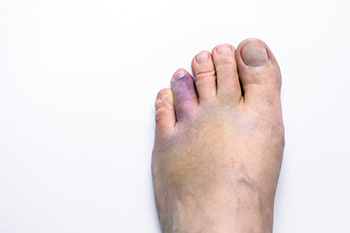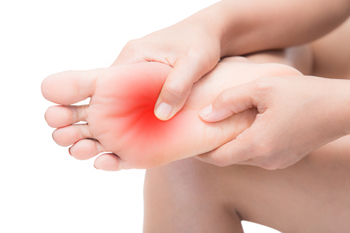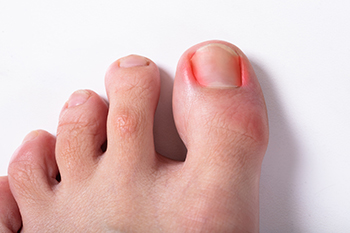Connect With Us
Blog
Items filtered by date: October 2023
Foot Exercises for Better Balance

When considering your workout routine, it is easy to overlook your feet and ankles. These often neglected body parts bear your body weight and support nearly all your movements. The foot and ankle complex is a marvel of anatomy, with 26 bones, numerous muscles, and countless nerve endings. During activities such as running and jumping, the foot and ankle endure significant forces, sometimes exceeding your body weight by several times. Moreover, they manage forces in multiple directions, contributing to their intricate biomechanics. Stretching and strengthening the foot and ankle complex is vital for overall physical health and injury prevention, as it can reduce the shockwave of force traveling into the shins, knees, and beyond. Neglecting this area can lead to common injuries. Stretching is also vital to maintain balance. An easy exercise to do for balance training consists of standing on one leg for 30 seconds, then repeat on the other side. Alternate between the two legs for three rounds. Once you can complete that with ease, repeat the progression on a soft surface such as a pillow. For advanced balance training, repeat the sequence above and close your eyes. If you would like to know more about various foot exercises you can do for balance, it is suggested that you make an appointment with a podiatrist who can provide you with the knowledge you are seeking.
Exercising your feet regularly with the proper foot wear is a great way to prevent injuries and build strength. If you have any concerns about your feet, contact Dr. Howard Horowitz from Bowie Foot & Ankle . Our doctor can provide the care you need to keep you pain-free and on your feet.
Exercise for Your Feet
Exercise for your feet can help you gain strength, mobility and flexibility in your feet. They say that strengthening your feet can be just as rewarding as strengthening another part of the body. Your feet are very important, and we often forget about them in our daily tasks. But it is because of our feet that are we able to get going and do what we need to. For those of us fortunate enough to not have any foot problems, it is an important gesture to take care of them to ensure good health in the long run.
Some foot health exercises can include ankle pumps, tip-toeing, toe rises, lifting off the floor doing reps and sets, and flexing the toes. It is best to speak with Our doctor to determine an appropriate regimen for your needs. Everyone’s needs and bodies are different, and the activities required to maintain strength in the feet vary from individual to individual.
Once you get into a routine of doing regular exercise, you may notice a difference in your feet and how strong they may become.
If you have any questions please feel free to contact our office located in Bowie, MD . We offer the newest diagnostic and treatment technologies for all your foot and ankle needs.
When to See a Doctor for a Broken Toe

Breaking a toe can result in pain, swelling, and bruising due to internal bleeding. The area may look misshapen, especially if the bone ends are displaced or if the fracture extends into the toe joint. The big toe, which bears more weight during walking, is especially painful when fractured. Distinguishing a broken toe from a sprain or strain can be challenging, but a misshaped toe often indicates a fracture. An X-ray is typically the definitive method for diagnosis. Broken toes are common and often do not require specific treatment. However, it is essential to see a podiatrist if pain intensifies, swelling persists, or if the toe appears misaligned. For more severe toe fractures, treatment can involve a cast, especially for the big toe, which plays an essential role in balance. Surgery may be necessary in some cases, which can involve using metal wires, plates, or external fixation methods. Possible complications post-fracture include failed bone healing, infections, stiffness, persistent pain, and post-traumatic arthritis. If you have a broken toe that is not healing on its own, it is strongly suggested that you make an appointment with a podiatrist for necessary treatment.
Broken toes may cause a lot of pain and should be treated as soon as possible. If you have any concerns about your feet, contact Dr. Howard Horowitz from Bowie Foot & Ankle . Our doctor will treat your foot and ankle needs.
What Is a Broken Toe?
A broken toe occurs when one or more of the toe bones of the foot are broken after an injury. Injuries such as stubbing your toe or dropping a heavy object on it may cause a toe fracture.
Symptoms of a Broken Toe
- Swelling
- Pain (with/without wearing shoes)
- Stiffness
- Nail Injury
Although the injured toe should be monitored daily, it is especially important to have a podiatrist look at your toe if you have severe symptoms. Some of these symptoms include worsening or new pain that is not relieved with medication, sores, redness, or open wounds near the toe.
If you have any questions, please feel free to contact our office located in Bowie, MD . We offer the newest diagnostic and treatment technologies for all your foot care needs.
Charcot-Marie Tooth Disease

Charcot-Marie-Tooth disease, or CMT, is a group of genetic disorders that affect the peripheral nerves responsible for transmitting signals between the brain, spinal cord, and the rest of the body. It can also impact the nerves controlling muscle function. Symptoms typically manifest in adolescence or early adulthood, often beginning in the feet and lower legs before spreading to the hands and arms. Common signs include muscle weakness, reduced muscle bulk, diminished reflexes, sensory loss, and foot deformities. CMT is a genetic condition, with various types resulting from mutations in different genes. The two primary categories are CMT1, characterized by issues with the myelin sheath surrounding nerves, and CMT2, involving abnormalities in the nerve axons themselves. CMT3, or Dejerine-Sottas disease, is a severe form that begins in infancy. There is no cure for CMT, but treatment focuses on managing symptoms and maintaining mobility. If you know you have Charcot-Marie Tooth disease or have symptoms characterizing this disease, it is suggested that you make an appointment with a podiatrist for a proper diagnosis and treatment.
Neuropathy
Neuropathy can be a potentially serious condition, especially if it is left undiagnosed. If you have any concerns that you may be experiencing nerve loss in your feet, consult with Dr. Howard Horowitz from Bowie Foot & Ankle . Our doctor will assess your condition and provide you with quality foot and ankle treatment for neuropathy.
What Is Neuropathy?
Neuropathy is a condition that leads to damage to the nerves in the body. Peripheral neuropathy, or neuropathy that affects your peripheral nervous system, usually occurs in the feet. Neuropathy can be triggered by a number of different causes. Such causes include diabetes, infections, cancers, disorders, and toxic substances.
Symptoms of Neuropathy Include:
- Numbness
- Sensation loss
- Prickling and tingling sensations
- Throbbing, freezing, burning pains
- Muscle weakness
Those with diabetes are at serious risk due to being unable to feel an ulcer on their feet. Diabetics usually also suffer from poor blood circulation. This can lead to the wound not healing, infections occurring, and the limb may have to be amputated.
Treatment
To treat neuropathy in the foot, podiatrists will first diagnose the cause of the neuropathy. Figuring out the underlying cause of the neuropathy will allow the podiatrist to prescribe the best treatment, whether it be caused by diabetes, toxic substance exposure, infection, etc. If the nerve has not died, then it’s possible that sensation may be able to return to the foot.
Pain medication may be issued for pain. Electrical nerve stimulation can be used to stimulate nerves. If the neuropathy is caused from pressure on the nerves, then surgery may be necessary.
If you have any questions, please feel free to contact our office located in Bowie, MD . We offer the newest diagnostic and treatment technologies for all your foot care needs.
Causes of a Sore Toe

Toe pain can result from various causes, often associated with factors such as excessive exercise or wearing ill-fitting shoes. Identifying the source of your discomfort can be aided by recognizing specific symptoms. Some potential causes of toe pain can include an ingrown toenail, a bunion, Raynaud’s, or Chilblains. A broken toe or gout can also result in an ingrown toenail which can happen from the toenail curving into the skin of the toe. A bunion is a hard, bony lump near the big toe. Raynaud’s or Chilblains refers to pain, tingling, and numbness experienced in the toes, particularly when they are exposed to cold or stress, possibly leading to changes in color. A broken toe creates swelling, redness, and bruising of the affected toe making it painful to walk. Gout typically affects the big toe joint with a sudden onset of pain, stiffness, and red or hot swollen skin around the toe joint. If you have toe pain and are uncertain about its cause, it is suggested that you make an appointment with a podiatrist for a proper diagnosis and treatment.
Toe pain can disrupt your daily activities. If you have any concerns, contact Dr. Howard Horowitz of Bowie Foot & Ankle . Our doctor can provide the care you need to keep you pain-free and on your feet.
What Causes Toe Pain?
Most severe toe pain is caused due to a sports injury, trauma from dropping something heavy on the toe, or bumping into something rigid. Other problems can develop over time for various reasons.
Toe pain can be caused by one or more ailments. The most common include:
- Trauma
- Sports injury
- Wearing shoes that are too tight
- Arthritis
- Gout
- Corns and calluses
- Hammertoe
- Bunions
- Blisters
- Ingrown toenails
- Sprains
- Fractures (broken bones)
- Dislocations
When to See a Podiatrist
- Severe pain
- Persistent pain that lasts more than a week
- Signs of infection
- Continued swelling
- Pain that prevents walking
Diagnosis
In many cases the cause of toe pain is obvious, but in others, a podiatrist may want to use more advanced methods to determine the problem. These can range from simple visual inspections and sensation tests to X-rays and MRI scans. Prior medical history, family medical history, and any recent physical traumatic events will all be taken into consideration for a proper diagnosis.
Treatment
Treatments for toe pain and injuries vary and may include shoe inserts, padding, taping, medicines, injections, and in some cases, surgery. If you believe that you have broken a toe, please see a podiatrist as soon as possible.
If you have any questions please feel free to contact our office located in Bowie, MD . We offer the newest diagnostic tools and technology to treat your foot and ankle needs.
Do Not Ignore Ingrown Toenails

Even if it does not cause pain, it is recommended that one does not ignore an ingrown toenail. Ingrown toenails happen when the corner or side of the toenail grows into the surrounding flesh, leading to pain, discomfort, inflammation, and sometimes infection. Initially a minor annoyance, untreated ingrown toenails can escalate into a recurring and serious issue. Treatment methods depend on the ingrown toenail's severity, the presence of infection, and previous treatments that were attempted. Routine podiatry care, including toenail trimming and addressing underlying issues, can help prevent infected ingrown toenails. Options range from daily foot soaking and antibiotics to more invasive nail avulsion procedures, which involve removing the affected toenail. If you have an ingrown toenail, it is strongly suggested that you make an appointment with a podiatrist for treatment.
Ingrown toenails may initially present themselves as a minor discomfort, but they may progress into an infection in the skin without proper treatment. For more information about ingrown toenails, contact Dr. Howard Horowitz of Bowie Foot & Ankle . Our doctor can provide the care you need to keep you pain-free and on your feet.
Ingrown Toenails
Ingrown toenails are caused when the corner or side of a toenail grows into the soft flesh surrounding it. They often result in redness, swelling, pain, and in some cases, infection. This condition typically affects the big toe and may recur if it is not treated properly.
Causes
- Improper toenail trimming
- Genetics
- Improper shoe fitting
- Injury from pedicures or nail picking
- Abnormal gait
- Poor hygiene
You are more likely to develop an ingrown toenail if you are obese, have diabetes, arthritis, or have any fungal infection in your nails. Additionally, people who have foot or toe deformities are at a higher risk of developing an ingrown toenail.
Symptoms
Some symptoms of ingrown toenails are redness, swelling, and pain. In rare cases, there may be a yellowish drainage coming from the nail.
Treatment
Ignoring an ingrown toenail can have serious complications. Infections of the nail border can progress to a deeper soft-tissue infection, which can then turn into a bone infection. You should always speak with your podiatrist if you suspect you have an ingrown toenail, especially if you have diabetes or poor circulation.
If you have any questions, please feel free to contact our office located in Bowie, MD . We offer the newest diagnostic and treatment technologies for all your foot care needs.

